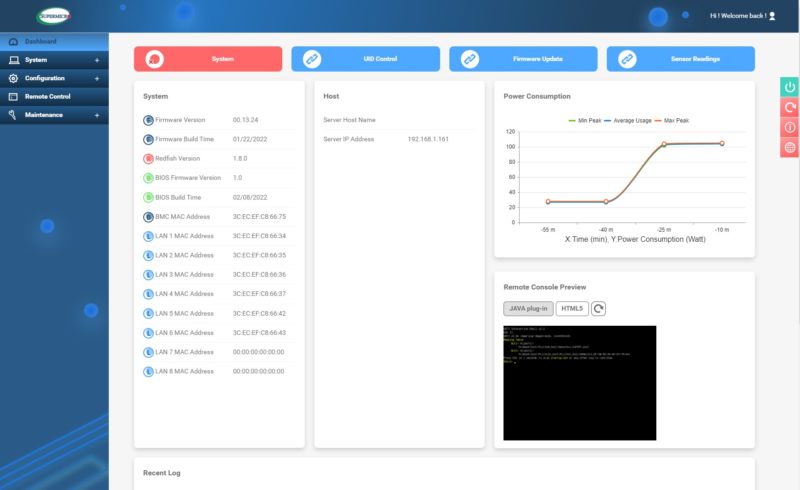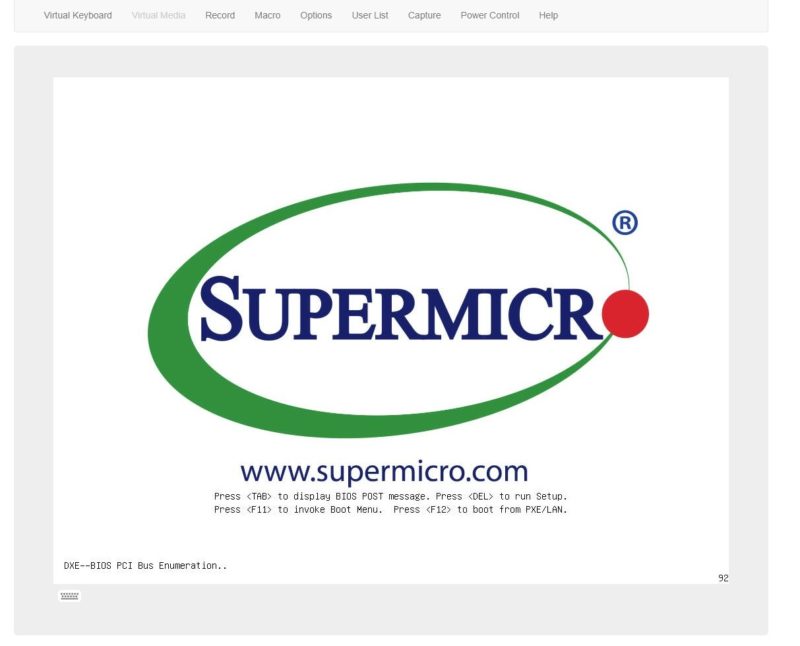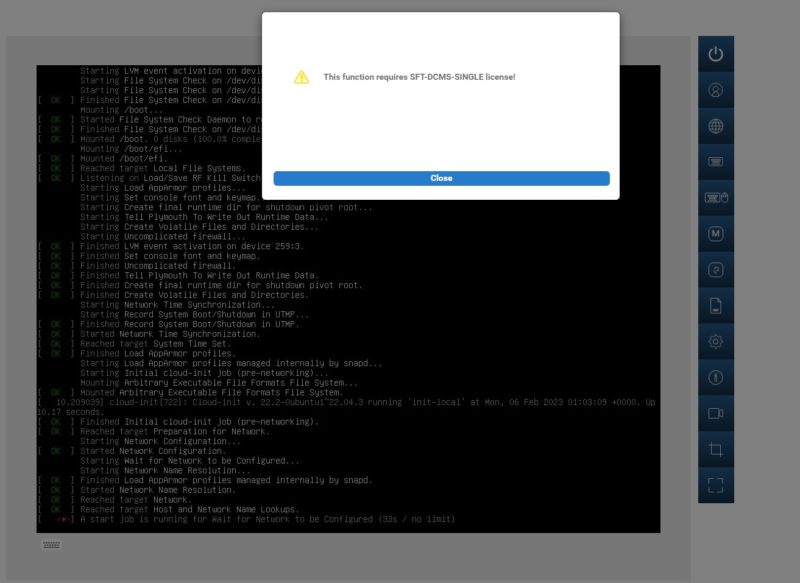Supermicro X12SDV-4C-SP6F Management
This is one of Supermicro’s X12 generation platforms. As such, it is using the newer ASPEED AST2600 BMC.

That means we get an updated Supermicro IPMI management interface (and Redfish API) solution versus what we saw on the X10SDV or X11SDV platforms.

That includes features like HTML5 iKVM functionality included.

One change that we highlighted recently is that with the HTML5 iKVM, one now needs a license to remote mount media directly when using this solution. We discuss other ways to mount media in the new era of Supermicro management in How to Add Virtual Media to a Supermicro Server via HTML5 iKVM Web IPMI Interface.

Aside from what is on the motherboard, Supermicro has a number of other tools to help manage its platforms.

If you recall the photo with the unique BMC password sticker, this is mandated due to new laws that went into effect a few years ago.

You can learn more about why this is required so the old ADMIN/ ADMIN credentials will not work in Why Your Favorite Default Passwords Are Changing.
Next, let us get to the performance.
Intel Xeon D-1718T Performance
First, since many will not have seen it yet, here is the lscpu output for the Intel Xeon D-1718T. This is an Ice Lake-D chip so its capabilities will closely match other Ice Lake parts like the 3rd Generation Intel Xeon processor line, codenamed “Ice Lake”. That is by design. Intel wants to ensure that it has parity between data center and edge platforms.

This part does not have Intel QuickAssist. That is a feature many of our readers may want. If you want to learn more about Intel QAT and the Ice Lake-D series, see our Intel Xeon D-2700 Onboard QuickAssist QAT Acceleration Deep-Dive.
We are instead going to focus on a few benchmarks that tie to our older results.
Python Linux 4.4.2 Kernel Compile Benchmark
This is one of the most requested benchmarks for STH over the past few years. The task was simple, we have a standard configuration file, the Linux 4.4.2 kernel from kernel.org, and make the standard auto-generated configuration utilizing every thread in the system. We are expressing results in terms of compiles per hour to make the results easier to read:

While this is still a 4-core / 8-thread CPU, the inclusion of turbo frequencies and faster memory helps to increase performance here dramatically. This platform is almost in another stratosphere compared to the older Broadwell-DE parts.
7-zip Compression Performance
7-zip is a widely used compression/ decompression program that works cross-platform. We started using the program during our early days with Windows testing. It is now part of Linux-Bench.

Again, we see very solid performance here. This is sorted by compression speed, but it is still very competitive with higher core count and TDP parts.
OpenSSL Performance
OpenSSL is widely used to secure communications between servers. This is an important protocol in many server stacks. We first look at our sign tests:

Here are the verify results:

Again, the new chip performs extremely well here. At the same time, this is one where Intel is now pushing the concept of using QAT acceleration. So if you wanted faster OpenSSL or compression, Intel’s answer would be to not use the CPU cores and instead get a SKU with QAT onboard.
NAMD Performance
Bringing this back a bit, we wanted to see what would happen with NAMD if we did not use AVX2/ AVX-512 to get more of a base compute performance view.

Here we can see that even without using the new instructions so all chips are on a more level playing field, the new part is close to an 8-core, 16-thread Intel Xeon D-1537 than the older D-1518. This is clearly an area where Intel has fairly massive performance gains on the CPU side. Using accelerators like VNNI for AI inference, AVX-512, or in other SKUs things like QAT accelerators would show much larger gains.
As a quick note, because this motherboard requires active chassis cooling, we are going to do our power consumption testing in a future fully-configured system review. Still, directionally this will use more power than the older Xeon D-1518/ D-1521 X10SDV platforms.
Next, let us get to the topology, the new Intel E823-L NIC, and our final words.




What is the measured performance of the 25gb network port? I am asking because I don’t expect much based on the single lane PCIe Gen 2 connection documented by the lspci output
We run in the 24-25Gbps range on those ports fairly easily. The 25GbE ports are SoC, not PCIe devices like the i210/i350. IIRC the D-1700 series actually has a 100GbE capable network segment so 2x 25GbE is not huge.
Do you have figures for power consumption?
Of course, it is expected to draw more than a D-1518 but is it as bad at idle as the D-2100 series?
“The two 25GbE ports are showing as the OpenFabrics RDMA devices.” Shouldn’t this be: “The two 25GbE ports are showing as Ethernet and OpenFabrics RDMA devices.” ?
it would be interesting if the active-cooler/heatsink of the Xeon-D 2100 fits (SNK-C0111AP4L), in this case the cooling Problem will be solved.
I’d like to notice one thing, although there are 2 SlimSAS ports for U.2/U.3 nvme drives, Supermicro does not offer any cabling for powering those drives and they are not officially supported. There is a JPH1 header for powering disks, but Supermicro said it allows max 2 Sata SSDs. Since U.3 drives are more power hungry, I’d say even if you do manage some combination with cabling, you are limited with providing power through that pins header.
Patrick, I would be very grateful if you could shed some light on this situation, since you have a direct communication with Supermicro representatives.
I’m hoping for an mini-itx version to replace my X10SDV board.
https://www.supermicro.com/en/products/motherboard/x12sdv-4c-spt4f
This is the Mini-ITX version.
Do somebody know if this mobo supports PCIe bifurcation? I haven’t found it in their webpage.
@frankovics.andras: They’ve spelled it wrong, in manual it says :
“Use this feature to configure the bifuraction setting for the PCIe port. The options are
Auto and x4x4x8”
I love the Supermicro SYS-5028D-TN4T which is the XEON D-1541 on a Supermicro X10SDV-TLN4F mobo in a mini-tower with hotswappable 3.5″ trays and provision for 2 more 2.5″ internal disks and the mobo has onboard 2x10Gbe RJ45 and 2x1Gbe.
those originally shipped with a 250W bronze PSU but later were shipped with a 350W GOLD PSU (thats the one I purchased).
In my eyes those X10 gen supermicro mini tower bundles competed directly with the HP ProLiant Microserver Gen10 and the SM blew the HP away in price comparison, performance and features.
I love the newer version reviewed here too, but it is no longer as affordable like the Supermicro X10 with Intel XEON D 1500 series was, and it doesn’t have active cooling or a minitower chassis option (yet), although the newer has far better specs. It’s still probably less expensive than the HP Micro Server though :D
Another important topic regarding Supermicro motherboard purchases. If you go to their e-store they no longer allow for barebone or motherboard purchases by themselves.
In other words, you can’t just purchase this motherboard from Supermicro. You’d have to purchase it inside of a chassis. And that’s not all. You have to purchase it with at least one stick of RAM, at least one disk, and bundled keyboard and mouse.
If you go to a retailer such as Wired Zone, which drop ships from Supermicro, it’s the same problem. They’ll display it as a motherboard for about $890 USD (currently as of me writing this) which you can purchase. But wiredzone will contact you after ordering it to let you know it’s on hold unless you bundle it with memory, disk and keyboard with mouse.
It’s crazy. The only way you can obtain just the motherboard standalone is if purchasing it from a seller that doesn’t drop ship it from Supermicro.
It’s a little bit crazy.
@frankovics.andras thanks, but unfortunately it have limited storage options. I would have liked to see one or two sata port which would bring the total up to 6.
And they are unhealthy expensive here in Europe.
@Casper: if you can even find them.
We are in the same boat. I would like to find a new, decent NAS mobo.
Im surprised patrick did not post any power draw numbers (even just a single value of what it pulls at idle is helpful).
great review still!! (best you will find anywhere) thanks!!
@Benny_RT2 that is unbelievable!! and makes sense as to why the only place you can find the motherboard ALONE is on ebay, and at a higher than MSRP price. Very unfortunate that supermicro has been moving in this direction over the past few years (ie trying to extract $ out of every angle)
I would love to see a review of the Mini-ITX version of this board as it has Dual 10GBase-T LAN instead of the 4Gb ports thus a lot more potential use cases.
https://www.supermicro.com/en/products/motherboard/x12sdv-4c-spt4f
@ m4dm4n
> There is a JPH1 header for powering disks
This header (which is molex male) is found on many supermicro motherboards with soldered CPU (e.g. c2750 boards, X10SDV series, X11SBA-LN4F) to provide power to disks but I can’t find a cable anywhere. It would need to be molex female to SATA female but such a cable just doesn’t seem to exist. Does anyone know whether Supermicro carries a cable? I haven’t been able to find any reference to a cable in any manuals of any of the many Supermicro boards that have a male molex header on the motherboard.
> it would be interesting if the active-cooler/heatsink of the Xeon-D 2100 fits (SNK-C0111AP4L), in this case the cooling Problem will be solved.
I purchased a SNK-C0111AP4L from Wired Zone to test this out. The screw holes align perfectly, but the chokes next to the barcode sticker block the cooler from being screwed in. I ended up using a dremel to remove the ~.25″ x 1″ section of the heatsink that overlaps with the chokes. It wasn’t super straightforward, but the cooler fits like a glove now, with my CPU running 20C cooler than stock.
I’ve connected the CPU fan to FAN1 per the manual, though the fan is fairly loud. I’ll likely replace it with a Noctua 40mm. The SNK-P0070APS4 also looks interesting, and the base appears to be low profile enough to not require modification, but I’m not certain it uses the same screw hole pattern.